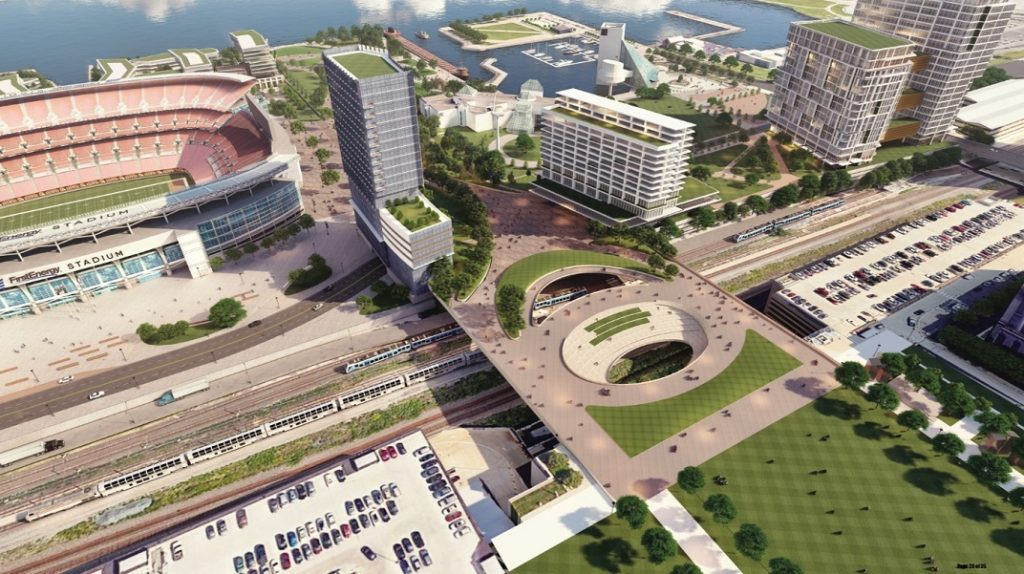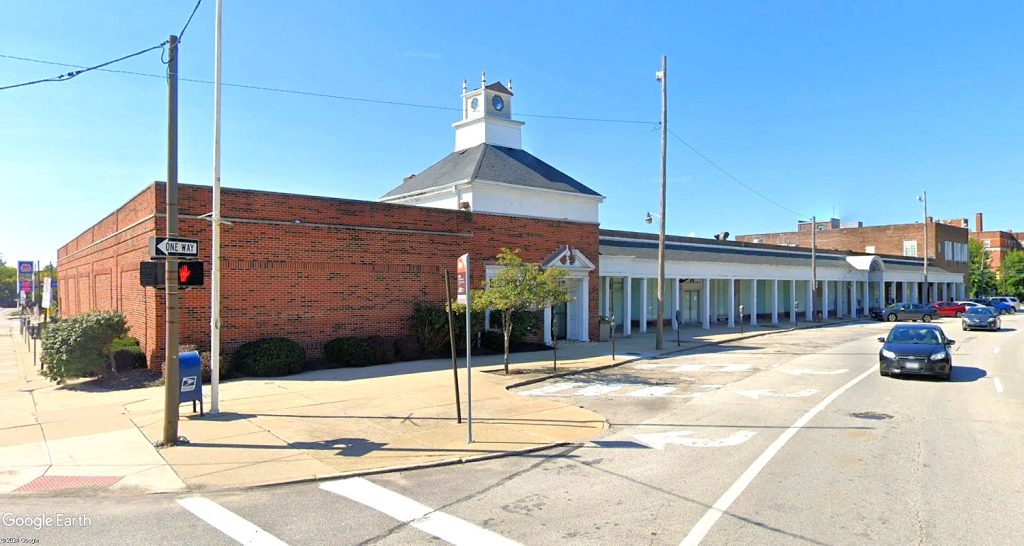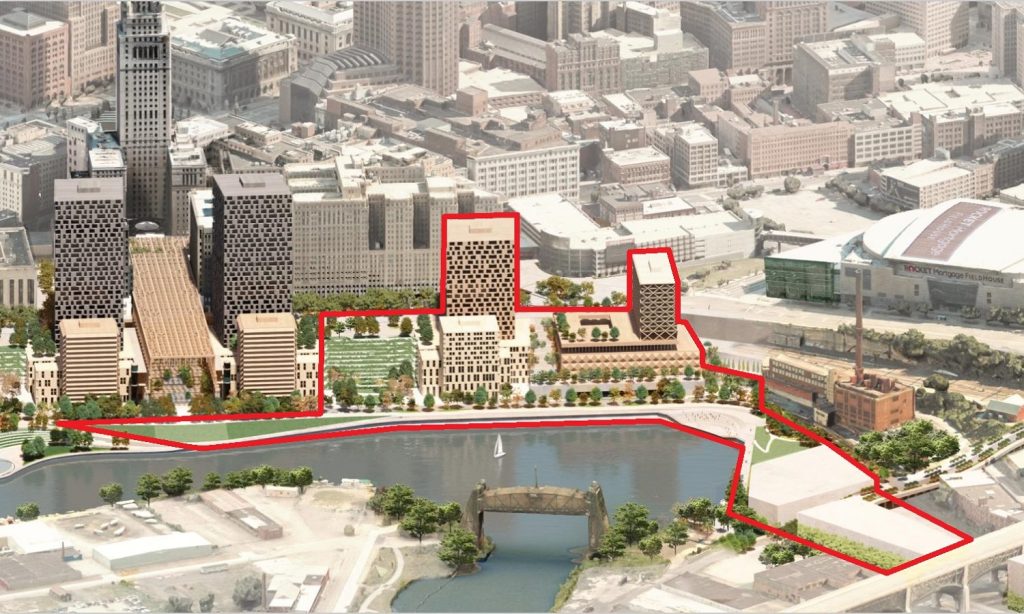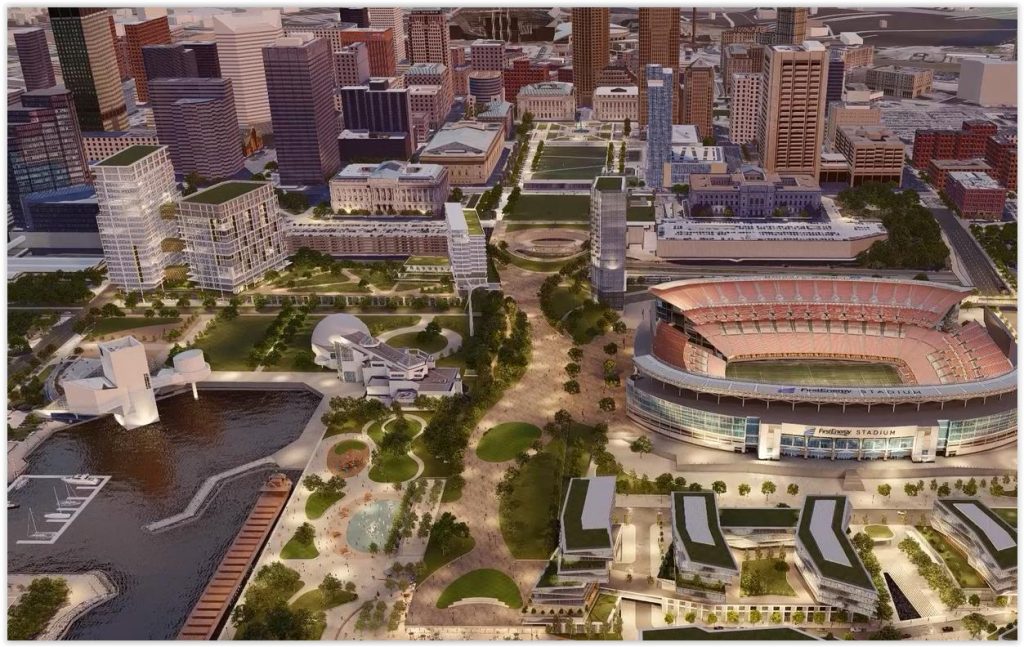
At the center of this image is the North Coast Connector land bridge. It is also at the center of everything city and community development officials want to do with the lakefront. Not only will the land bridge more seamlessly link the central business district with the lakefront, officials say it will also foster new development by relocating stadium parking spaces from the water’s edge (at bottom) and by creating new development sites next to the land bridge (AoDK). CLICK IMAGES TO ENLARGE THEM.
Public meetings for land bridge start this week
The North Coast Connector — a project that’s considered by many city and community development officials as the key to unlocking the potential of downtown Cleveland’s lakefront — is starting to come together. The state is moving forward on a big piece of funding for its construction. The city is moving forward on funding for detailed architectural designs. And public involvement meetings to help shape those designs will be held starting this week. To quote Gloria Swanson in the 1950 classic movie “Sunset Boulevard,” the proposed land bridge is “ready for its close-up.”
Last fall, the city asked residents to consider concepts for the North Coast Connector, a proposed land bridge that would cross the railroad tracks and the Shoreway to reconnect the community to the lakefront. This spring, residents are asked to weigh in on how to make the North Coast Lakefront at the north edge of downtown a welcoming place for everyone through a master planning process. The community will be asked about what will create a sense of belonging and what they want to experience along the shores of Lake Erie.
The city will host three community visioning workshops that will be open to the public:
- Saturday, May 6, 2-4 p.m., Pivot Center-Inlet Dance Theatre, 2937 W. 25th St.
- Tuesday, May 9, 5:30-7:30 p.m., E.J. Kovacic Recreation Center, 6250 St. Clair Ave.
- Thursday, May 11, 12-1:30 p.m., via Zoom (register for meeting link)
The city will provide childcare, children’s activities and refreshments at the in-person workshops. While not required, pre-registration is requested for planning purposes. Participants are encouraged to register online or by calling 216-664-2210. For more information on the North Coast Lakefront or to submit feedback online, visit clevelandnorthcoast.com.
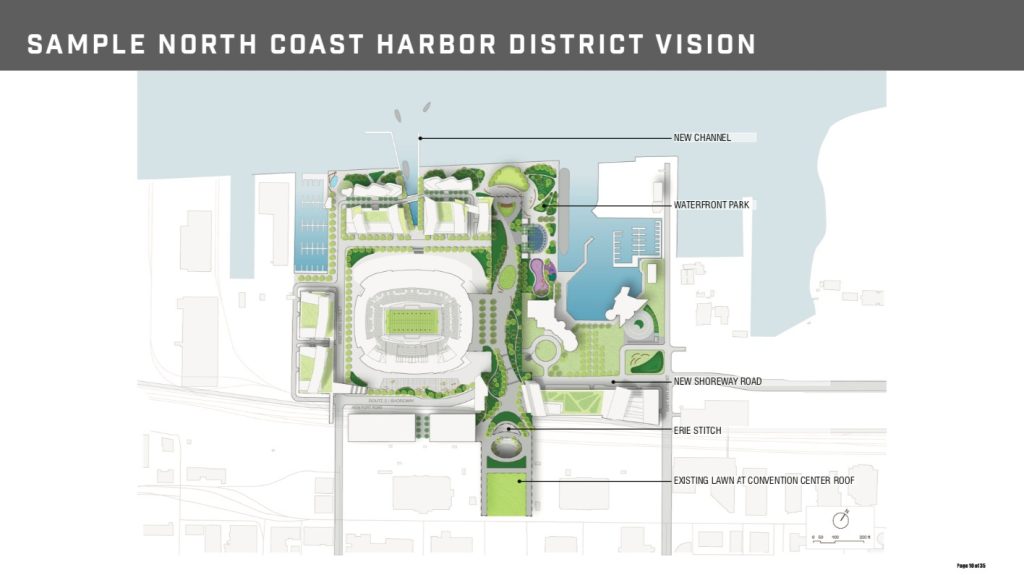
Conceptual site plan for the lakefront including the land bridge, shown here as “Erie Stitch.” It also shows to the left, or west of it buildings/parking garages over the lakefront railroad tracks. To the east and north of the tracks, additional development built atop new parking garages is shown (AoDK).
“The North Coast Connector and master plan signal our commitment to a city that is welcoming, accessible and thriving for all residents,” said Mayor Justin Bibb. “By uniting the community’s diverse voices in shaping the waterfront’s future, we will not only enhance the downtown lakefront area but will also create shared assets that meet the needs of Clevelanders for generations to come.”
Last week, the Ohio House of Representatives passed the state’s two-year budget which includes $62 million for the “Cleveland Municipal Land Bridge project” to be administered by the Ohio Department of Development’s Local Projects Fund. If the Ohio Senate and Gov. Mike DeWine concur, it will offer a significant share of funding for the North Coast Connector whose total cost is estimated to be in excess of $200 million.
The Mayor’s Office of Capital Projects is requesting City Planning Commission and City Council approval for $3 million from the city’s ARPA (American Rescue Plan Act, aka COVID-19 stimulus package) Waterfront Activation Fund to help pay the estimated $8 million to $10 million cost for the detailed design of the North Coast Connector project. The ARPA Waterfront Activation Fund focuses on activating the east side lakefront from the Collinwood neighborhood to downtown by funding transformative projects that have strong resident and community support. Projects supported by this fund are intended to advance the city’s values of equity, economic opportunity through redevelopment and sustainability.
According to a briefing paper from the Mayor’s Office of Capital Projects, the purpose of the North Coast Connector is to increase the connectivity between Cleveland’s downtown and the lakefront for multiple modes of transportation, while improving safe access to the lakefront and promote and enable economic redevelopment and revitalization along the lakefront. The primary needs include energizing and activating the connection between downtown and the Lakefront with improved connectivity for pedestrians and bicyclists, and promoting and enabling economic redevelopment and revitalization along the lakefront.
The secondary needs of the North Coast Connector, according to the briefing paper, include improving public transportation and rail connectivity, improving freight connectivity to and from the Port of Cleveland, create more efficient movements of all modes of travel, maintaining safe movements of various travel modes and fostering equity of lakefront access.
After an engineering analysis and public input in 2022, two basic design options for the North Coast Connection are still being considered. One option is to construct a land bridge that keeps the Shoreway as a highway. The second option is to construct a land bridge and to reconfigure the Shoreway into a boulevard with intersections at East 9th Street, West 3rd Street and in the vicinity of West 6th Street and Lakeside Avenue. The feasibility study will be completed and a preferred alternative identified in late 2023.
Cleveland Browns owner Jimmy Haslam recently said that he considered the North Coast Connector and a reconfigured Shoreway of utmost importance to his football team’s vission for renovating the city’s existing, 1999-built stadium before the team’s lease with the city ends after the 2028 football season.
“There’s a lot of infrastructure that has to go into connecting downtown, which is the first thing that has to happen,” Haslam said. “We’ve got to connect downtown to the waterfront, right? Everybody knows that. So you’ve got to relocate the highway.”
NEOtrans has learned from two sources that the North Coast Connector could include additional structures holding thousands of parking spaces between the Shoreway and the railroad tracks. Atop those structures flanking the land bridge are proposed to be several high-rise buildings with residential, hotel, office/co-working, retail, restaurant and recreational uses.

From a 2016 Cleveland City Planning Commission study came this conceptual rendering of the east end of a planned multimodal transportation center that would unite Greater Cleveland Regional Transit Authority buses and trains, Amtrak trains, and Greyhound buses into one facility that would extend two-thirds of a mile west to near West 3rd Street (CPC).
The parking is not only intended to support those uses, but also to accommodate the Browns’ lease with the city that requires there to be sufficient gameday parking near the stadium. Right now, much of that parking is provided in surface lots around the stadium, including along the water’s edge — something that everyone seems to want redeveloped with more attractive uses. And development of those parking lots may also provide revenues to the city to help it renovate Cleveland Browns Stadium.
Those same sources also said that, while constructing a lakefront multimodal transportation center that unites train and bus services is important, it may not be part of the land bridge. The sources said the transportation center could instead be built nearby. One option is to consolidate in the underside of the land bridge a station that replaces the West 3rd and East 9th stations for the Greater Cleveland Regional Transit Authority’s (GCRTA) light-rail Waterfront Line, adds a passenger station for Amtrak’s existing nighttime and proposed daytime trains to Midwest and East Coast cities, as well as local, regional and intercity buses.
Stu Nicholson, executive director of the rail and transit advocacy group All Aboard Ohio, wrote to city officials last week urging them to not overlook the findings from a 2016, city-funded study (11.2 MB PDF) which determined that the best place to build a multimodal transportation center in downtown Cleveland was near the site of the proposed land bridge and current Amtrak station.
“What we ask is that you please include in the final design for the North Coast Connector a multimodal transportation center that unites and seamlessly integrates connections between Amtrak trains, GCRTA buses and light-rail, intercounty bus services (i.e.: Laketran, Akron Metro), intercity buses (i.e.: Greyhound), plus more convenient pedestrian and bike links to the rest of downtown,” Nicholson wrote. “Uniting these modes can put under one roof more than 600,000 annual boardings into one facility, approaching the average annual attendance at Cleveland Browns home games. This will improve connectivity and jobs accessibility, boost the lakefront and local economy and tap into additional funding sources to build a larger and more attractive North Coast Connector.”
END

